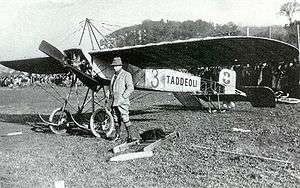Morane-Borel monoplane
The Morane-Borel monoplane (sometimes referred to with the retronym Morane-Saulnier Type A or simply the Morane monoplane; company designation Bo.1[1]) was an early French single-engine, single-seat aircraft. It was flown in several European air races.
| Morane-Borel monoplane | |
|---|---|
 | |
| Emile Taddéoli in ~1911/13 | |
| Role | Sports plane |
| Manufacturer | Morane brothers and Gabriel Borel |
| Designer | Raymond Saulnier |
| First flight | 1911 |
Design
The Monoplane was a mid-wing tractor configuration monoplane powered by a 50 hp Gnome Omega seven-cylinder rotary engine driving a two-bladed Chauvière Intégrale propeller. The fuselage was a rectangular-section wire-braced box girder, with the forward part covered in plywood and the rear part fabric covered: the rear section was left uncovered in some examples. The two-spar wings had elliptical ends and were braced by a pyramidal cabane in front of the pilot and an inverted V-strut underneath the fuselage, behind the undercarriage. Lateral control was effected by wing warping and the empennage consisted of a fixed horizontal stabiliser with tip-mounted full-chord elevators at either end and an aerodynamically balanced rudder, with no fixed vertical surface. In later examples the horizontal surfaces were modified, and consisted of a fixed surfacee with balanced elevators hinged to the trailing edge.[2] The undercarriage consisted of a pair of short skids, each carried on a pair of struts, and a pair of wheels on a cross-axle bound to the skids by bungee cords, and a tailskid.
A two-seat version was later produced, with the fuselage lengthened to 7.0 m (23 ft) and wingspan increased to 10 m (34 ft).[2]
Operational history
The Monoplane achieved fame when Jules Védrines flew one to victory in the 1911 Paris-to-Madrid air race, the only competitor to finish the four-day course. Later in the year he came second in the Circuit of Britain, flying an aircraft powered by a 70 hp Gnome.[3] Another was flown by André Frey in the Paris-Rome race in 1911, finishing third.[4] Emile Taddéoli was another owner of a Morane monoplane.
A two-seat version, powered by an 80 Gnome was entered for the 1912 British Military Aeroplane Competition.[2]
Surviving examples
In 2007, a single example remains extant, undergoing conservation work at the Canada Aviation Museum
Operators
Specifications
From: l'Aérophile, 15 April 1911, p. 170
General characteristics
- Crew: one
- Length: 6.50 m (21 ft 6 in)
- Wingspan: 9.50 m (31 ft 1 in)
- Wing area: 14 m2 (151 sq ft)
- Empty weight: 200 kg (441 lb)
- Gross weight: 430 kg (948 lb)
- Powerplant: 1 × Gnome Omega 7-cylinder air-cooled rotary piston engine , 37 kW (50 hp)
Performance
- Maximum speed: 111 km/h (69 mph, 60 kn)
References
- https://www.secretprojects.co.uk/threads/borel-designations.31755/
- The Borel MonoplaneFlight 20 July 1912 p. 651
- Daily Mail Circuit of Britain Flight 29 July 1911, p.661
- Villard, Henry Serrano (1987). Blue Ribbon of the Air. Washington D.C.: Smithsonian Institution. p. 158. ISBN 0 874 74 942 5.
- Taylor, Michael J. H. (1989). Jane's Encyclopedia of Aviation. London: Studio Editions. p. 193.
External links
| Wikimedia Commons has media related to Morane-Borel monoplane. |
- aviafrance.com
- Borel-Morane Monoplane, Canada Aviation and Space Museum
- Morane-Borel MonoplaneFlight, July 29, 1911.